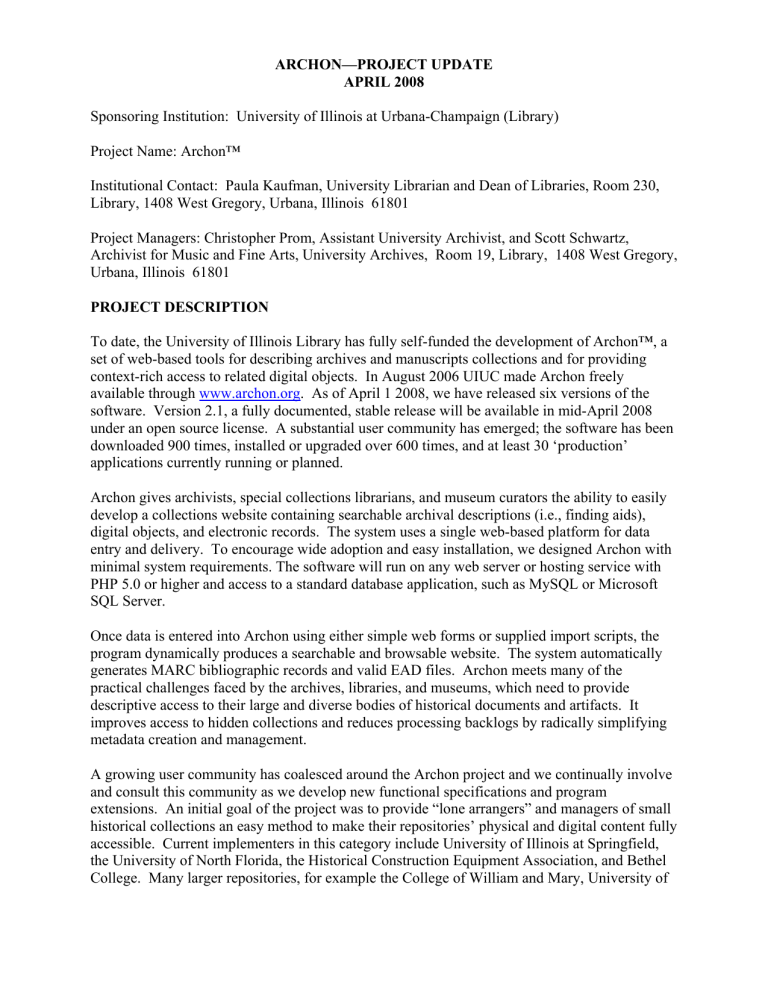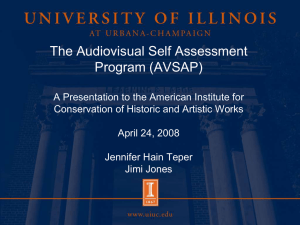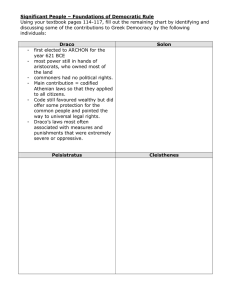ARCHON—PROJECT UPDATE APRIL 2008 Sponsoring Institution

ARCHON—PROJECT UPDATE
APRIL 2008
Sponsoring Institution: University of Illinois at Urbana-Champaign (Library)
Project Name: Archon™
Institutional Contact: Paula Kaufman, University Librarian and Dean of Libraries, Room 230,
Library, 1408 West Gregory, Urbana, Illinois 61801
Project Managers: Christopher Prom, Assistant University Archivist, and Scott Schwartz,
Archivist for Music and Fine Arts, University Archives, Room 19, Library, 1408 West Gregory,
Urbana, Illinois 61801
PROJECT DESCRIPTION
To date, the University of Illinois Library has fully self-funded the development of Archon™, a set of web-based tools for describing archives and manuscripts collections and for providing context-rich access to related digital objects. In August 2006 UIUC made Archon freely available through www.archon.org
. As of April 1 2008, we have released six versions of the software. Version 2.1, a fully documented, stable release will be available in mid-April 2008 under an open source license. A substantial user community has emerged; the software has been downloaded 900 times, installed or upgraded over 600 times, and at least 30 ‘production’ applications currently running or planned.
Archon gives archivists, special collections librarians, and museum curators the ability to easily develop a collections website containing searchable archival descriptions (i.e., finding aids), digital objects, and electronic records. The system uses a single web-based platform for data entry and delivery. To encourage wide adoption and easy installation, we designed Archon with minimal system requirements. The software will run on any web server or hosting service with
PHP 5.0 or higher and access to a standard database application, such as MySQL or Microsoft
SQL Server.
Once data is entered into Archon using either simple web forms or supplied import scripts, the program dynamically produces a searchable and browsable website. The system automatically generates MARC bibliographic records and valid EAD files. Archon meets many of the practical challenges faced by the archives, libraries, and museums, which need to provide descriptive access to their large and diverse bodies of historical documents and artifacts. It improves access to hidden collections and reduces processing backlogs by radically simplifying metadata creation and management.
A growing user community has coalesced around the Archon project and we continually involve and consult this community as we develop new functional specifications and program extensions. An initial goal of the project was to provide “lone arrangers” and managers of small historical collections an easy method to make their repositories’ physical and digital content fully accessible. Current implementers in this category include University of Illinois at Springfield, the University of North Florida, the Historical Construction Equipment Association, and Bethel
College. Many larger repositories, for example the College of William and Mary, University of
Iowa, Purdue University, University of Florida, Southern Illinois University at Carbondale, are actively using Archon or will soon launch production sites.
Archon was recently cited as an innovative tool to enhance access to hidden collections and may serve as a collections management tool used by other repositories for grant applications submitted to the CLIR’s recently-announced “Cataloging Hidden Collections and Archives” initiative. We have been invited to present at three upcoming conferences on sessions related to hidden collections, including the RBMS Preconference and the RLG Programs Metadata Tools
Forum. As a result, we expect that the growing user community will grow. This community requires support beyond that UIUC can reasonably be expected to provide from its own resources.
CURRENT SOFTWARE FEATURES
Archon is a unified platform for archival description and access. Archon's public interface consistently displays the most current information about a repository’s holdings because it is updated automatically when archival staff edits records. Once information has been entered, staff members need do nothing more to make the information instantly accessible, searchable, and browsable.
End-users can:
• Simultaneously search descriptions of archival materials, electronic records, and digital objects.
• Browse materials by collection title, digital object title, controlled subject heading, creator authority record, or archival record group.
•
•
•
View, print, and search finding aids for individual collections.
View, download, and use digital objects/electronic records.
Navigate easily between archival descriptions and related digital objects sharing the same collection, subject, creator, or archival record group.
Archives staff can:
• Create standards-compliant collection descriptions and full finding aids using web forms.
• Describe the series, subseries, files, and items within each collection.
•
•
Organize collections into record groups and subgroups based on provenance or function.
Develop creator authorities and controlled subject lists. Link them to collections and digital objects.
•
•
•
•
Track locations for containers or groups of containers.
List unprocessed materials in an accessions manager.
Upload digital objects/electronic records or link archival descriptions to external URLs.
Edit descriptive information directly from an enhanced public interface by clicking the
•
• edit icon: .
Use an integrated help system by clicking the help buttons: .
Export MARC and EAD records (for importation to other systems).
Archon administrators can:
• Define "Repository Level" information such as addresses and contact information
• Define record groups or other classification/arrangement schema.
• Customize the public interface by tailoring Archon’s easy-to-modify themes.
•
•
•
Create new output templates to display data in any way that a repository requires for its users (a default template is included).
Add, edit, or delete user accounts, allowing or denying people access to particular elements of the staff interface.
Batch import data from MARC, EAD (XML) or CSV format.
TECHNOLOGICAL PLATFORM/API
Archon’s Application Programming Interface (API) uses an object-oriented data model and a database abstraction layer to insulate developers from all but the most complex functions. All programming is completed within the context of the Archon API; functions and methods including database retrievals and storage are called within an “Archon” object and its associated sub-objects, functions and methods. A description of the technical platform is available at http://www.library.uiuc.edu/archives/workpap/ChapterEight-Prom.pdf
WORK RECENTLY COMPLETED OR PLANNED USING UIUC RESOURCES
•
Developed table-less, CSS-based layout, fully compliant with web-accessibility requirements/Section 508 (complete March 2008)
•
Developing digital library thumbnail browsing and enhanced searching.
•
Improving staff user interface with AJAX technologies.
•
Developing display mechanism to show accession records for unprocessed materials.
POTENTIAL PLANS WITH OTHER FUNDING
As Archon’s user community continues to grow, greater demands for specialized service and extensions have emerged. The community will benefit greatly from additional support and encouragement.
We believe UIUC must form a small advisory group from the Archon user community to help guide the project directors is defining priorities for future development. The advisory group would assist in developing functional specifications, suggesting user interface improvements, and—where appropriate—contributing to the code base. In addition, a temporary, full-time research programmer, working under UIUC direction, will significantly assist in future design and implementation of functions that are crucial to the entire Archon user community. Potential areas for work include:
•
Establishing concurrent version systems (SVN) repository to allow users to contribute toward code development (several have requested).
•
Adding capacity for end-users to annotate, repurpose, and reuse digital content.
•
Developing support for management and display of compound digital objects .
•
Programming a preservation assessment module.
•
Developing batch exporter for EAD/MARC files.
•
Designing a built-in OAI data provider for digital objects.
•
Adding support for persistent identifiers.
•
Building support for Archon API to link to other resources (e.g. D-Space, CONTENTdm records).
•
Studying potential use of Archon in larger (OAIS-based) preservation and access system.



